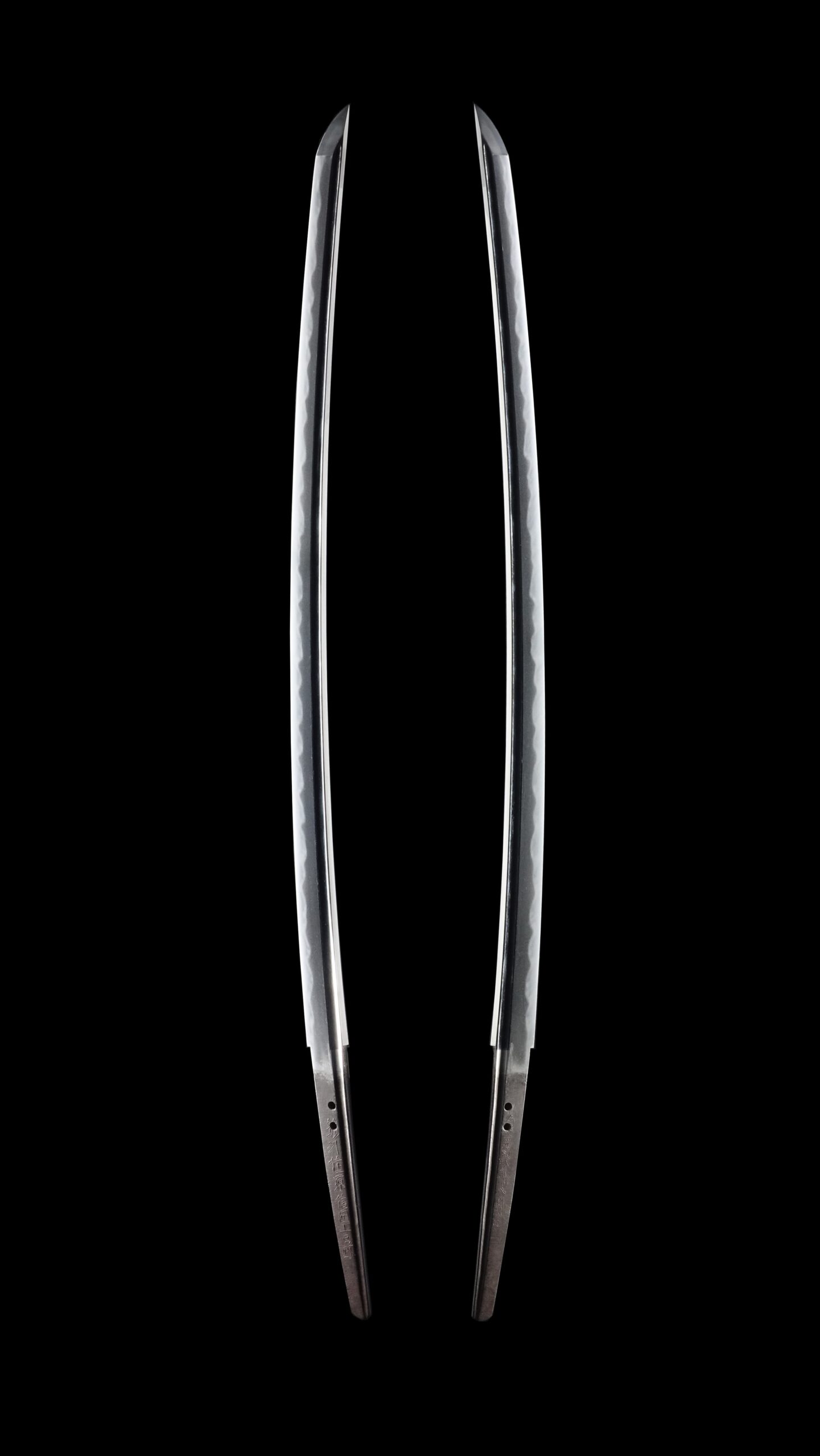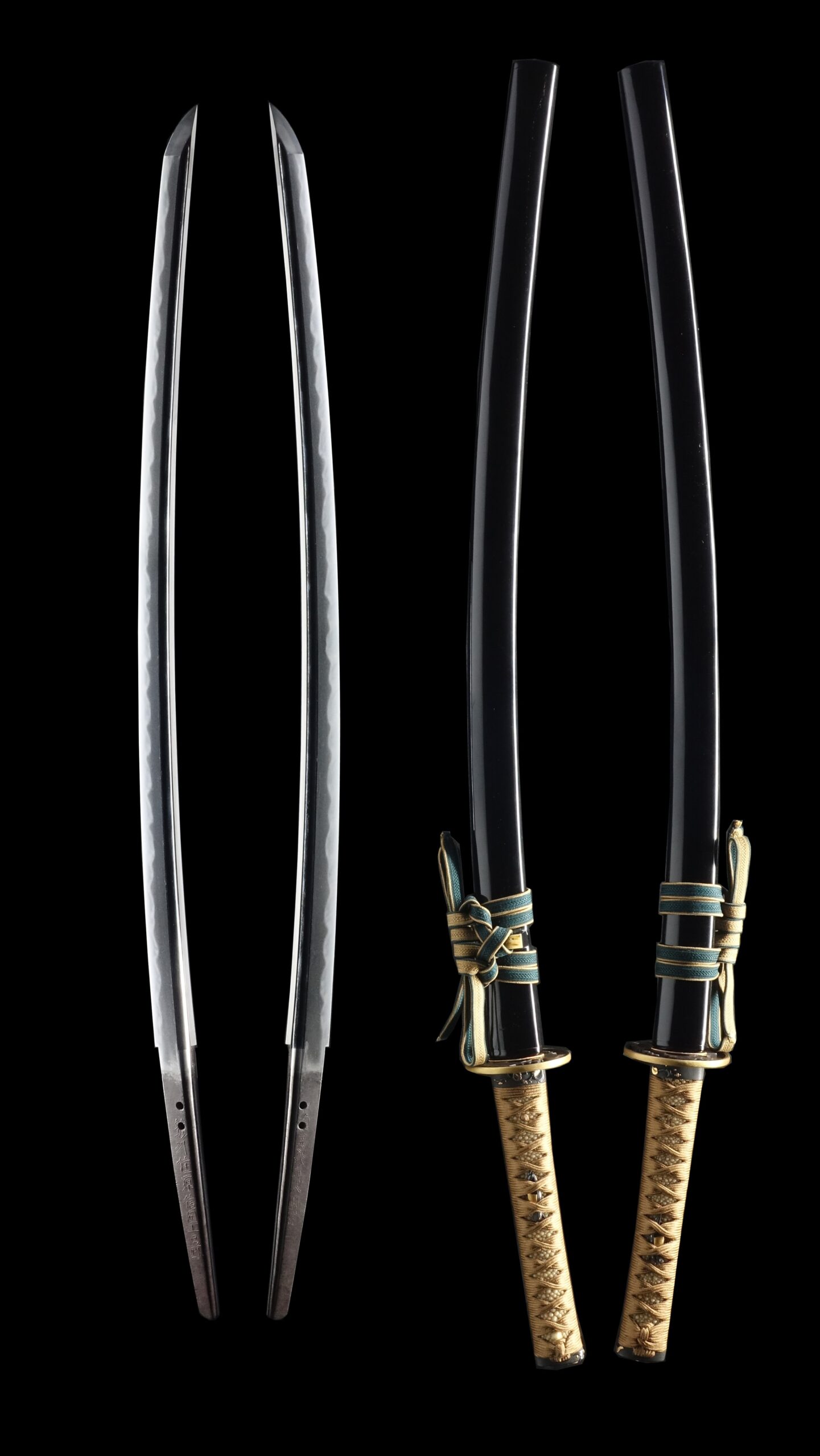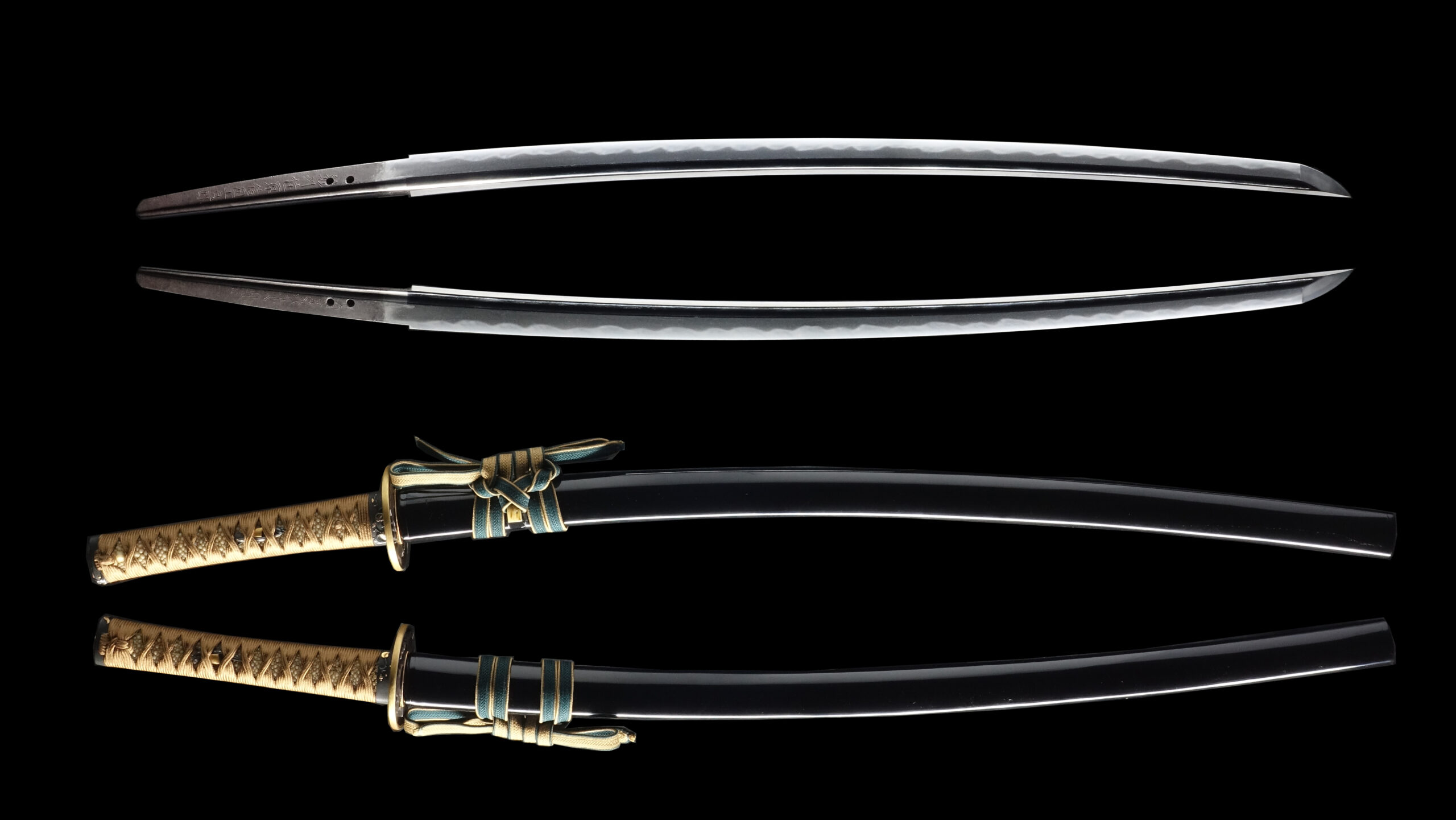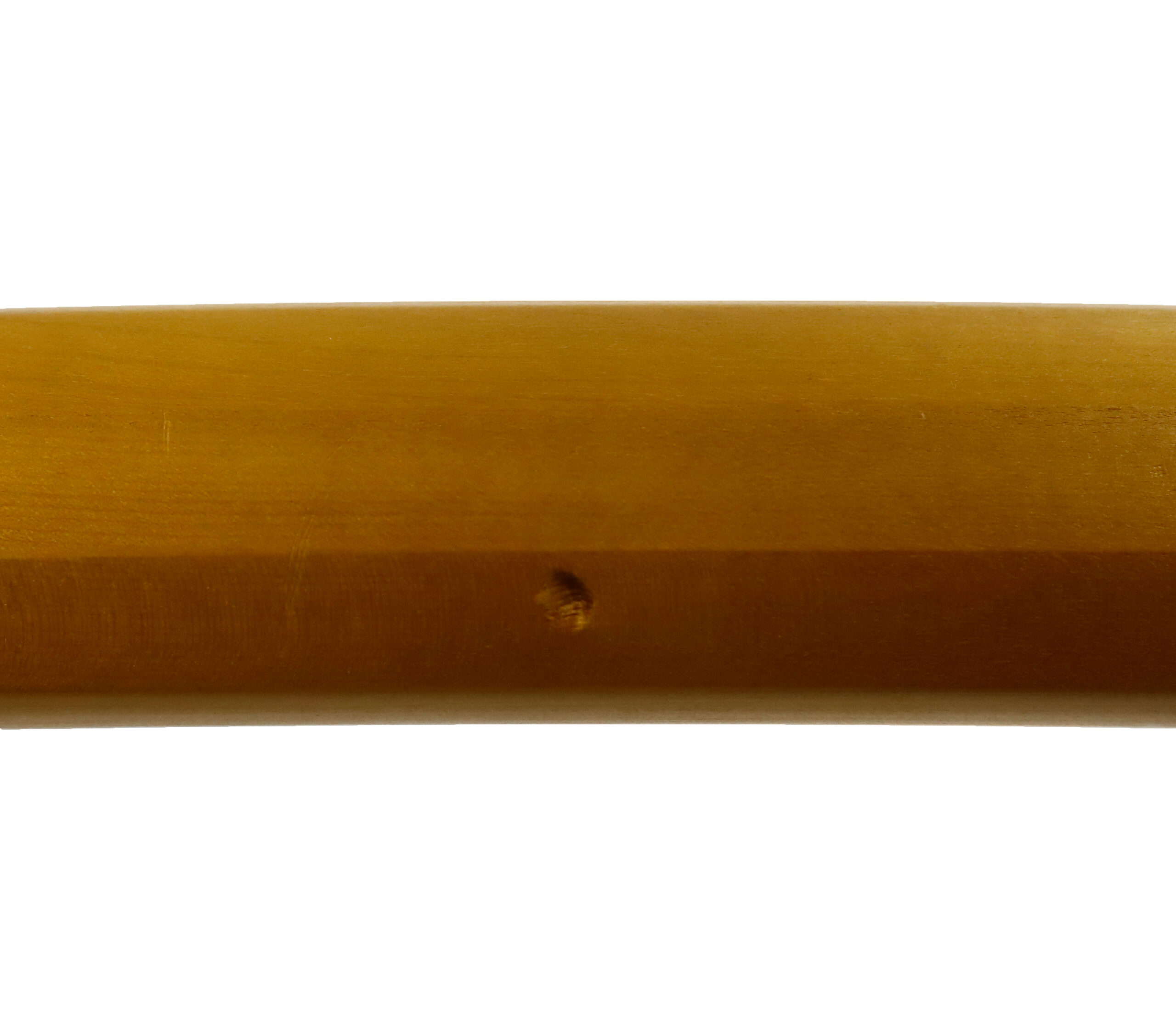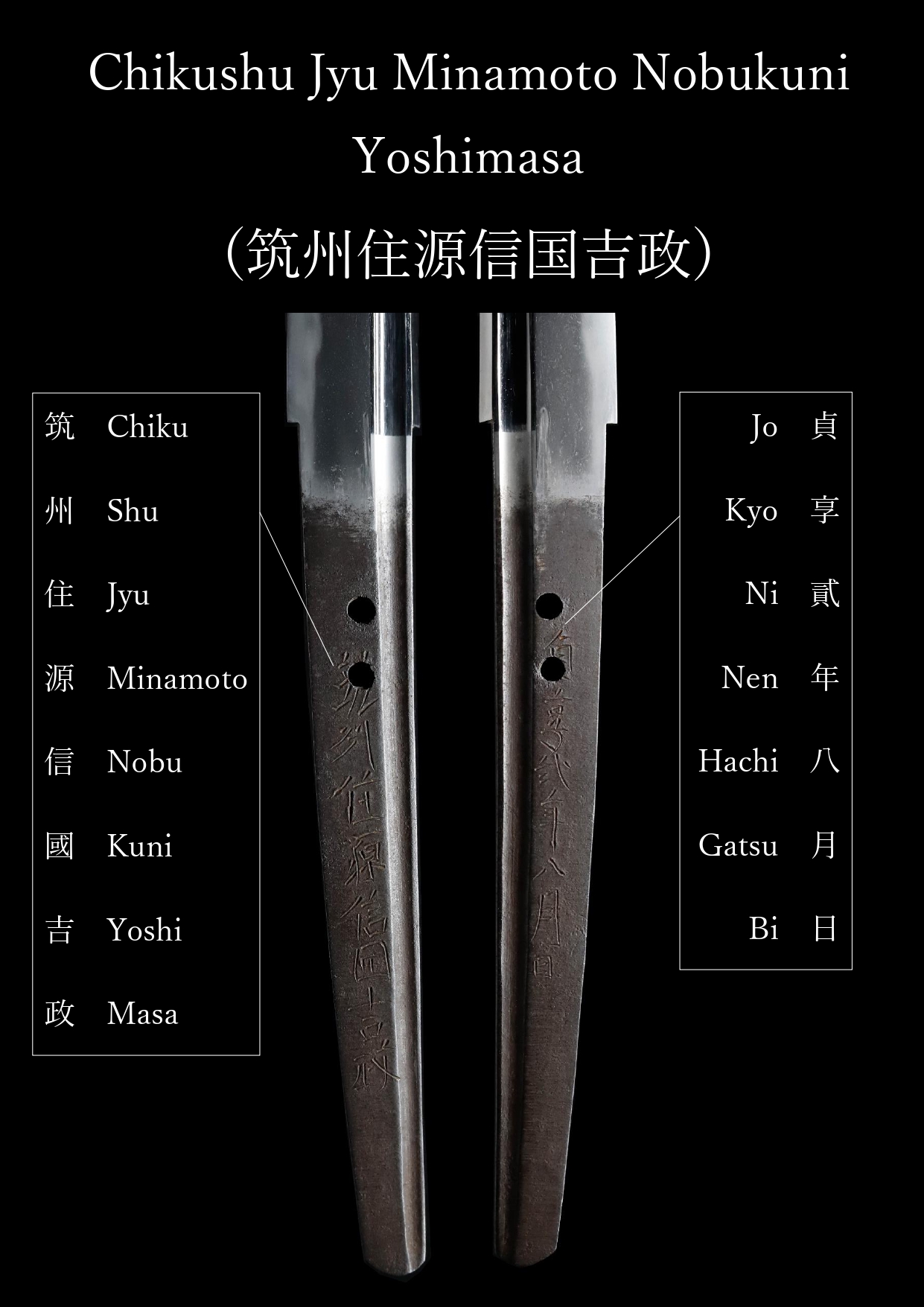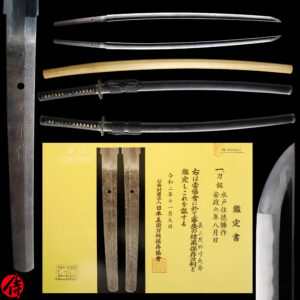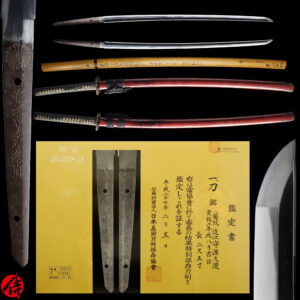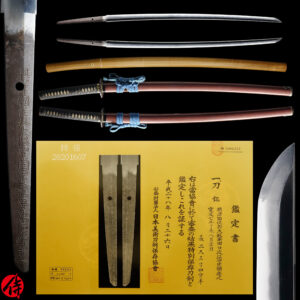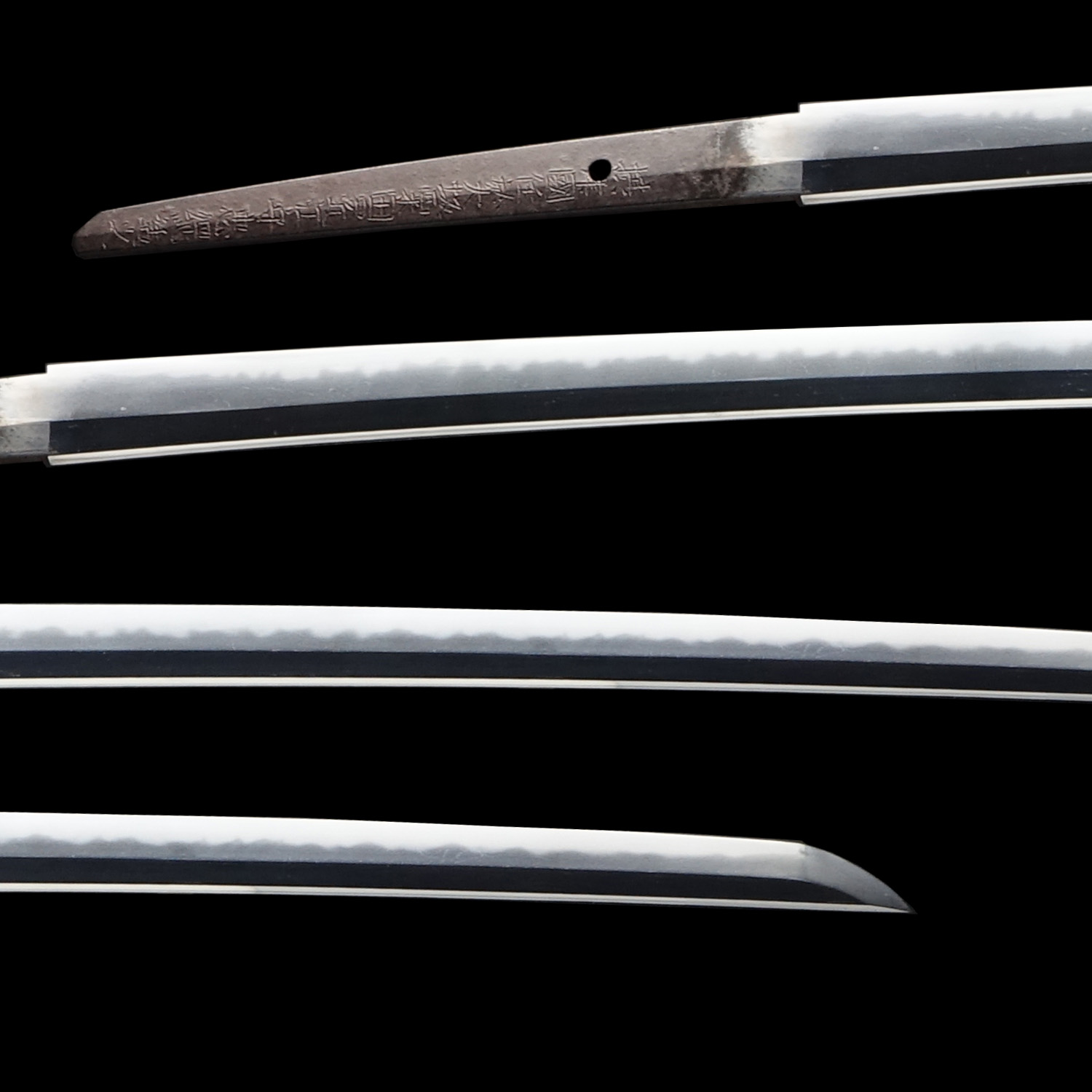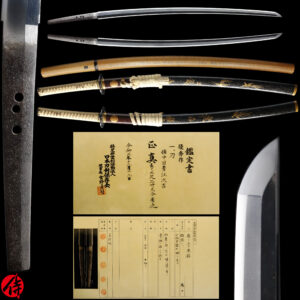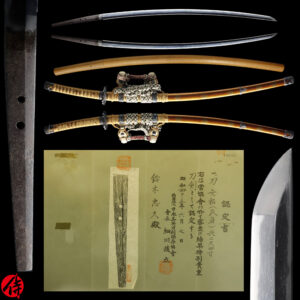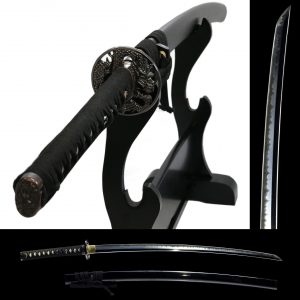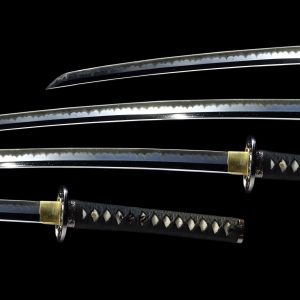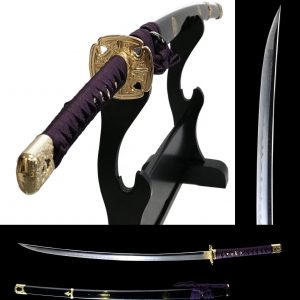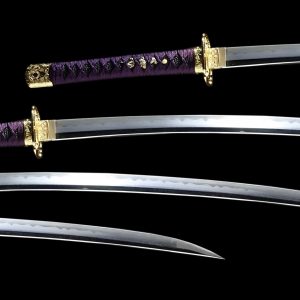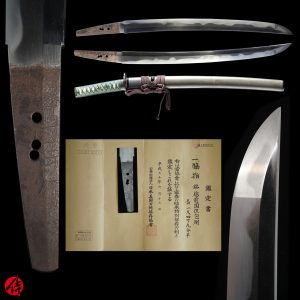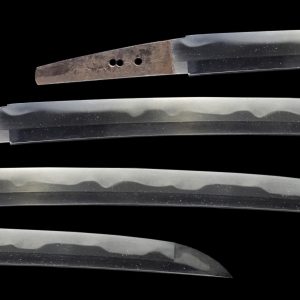Antique Japanese Sword Katana Signed by Nobukuni Yoshimasa with Tokubetsu Hozon Certificate & Tosogu
【Description】
Summary
This blade was signed by Chikushu Jyu Minamoto Nobukuni Yoshimasa (筑州住源信国吉政) in August, the second year of the Jokyo era (1685). Chikushu, also known as Chikuzen, is the province’s name located in Fukuoka prefecture today. Jyu means living. Minamoto Nobukuni is the name of his school, and Yoshimasa is his maker’s name. Those who belonged to Nobukuni School in Chikuzen province were called Tsukushi Nobukuni, one of the most prospered sword forging schools in Kyushu island during the Edo period.
The maker’s name Yoshimasa lasted three generations, and we believe it was signed by the second generation. The second-gen Yoshimasa is also known as Nobukuni Heishiro (信国平四郎). He was born as the second son of Nobukuni Yoshisada (信国吉貞) in the fifth year of the Gen-Na era (1618). Yoshisada was the founder of Tsukushi Nobukuni school, and his older brother was the first-gen Yoshimasa. The second-gen Yoshimasa was especially active during the Kanbun-Enpo era (1661-1681: Early Edo Period). There is also a record of him forging a sword in the second year of the Jyokyo era (1685). Based on these records, we believe this blade was forged at the end of his career when he mastered superb craftsmanship.
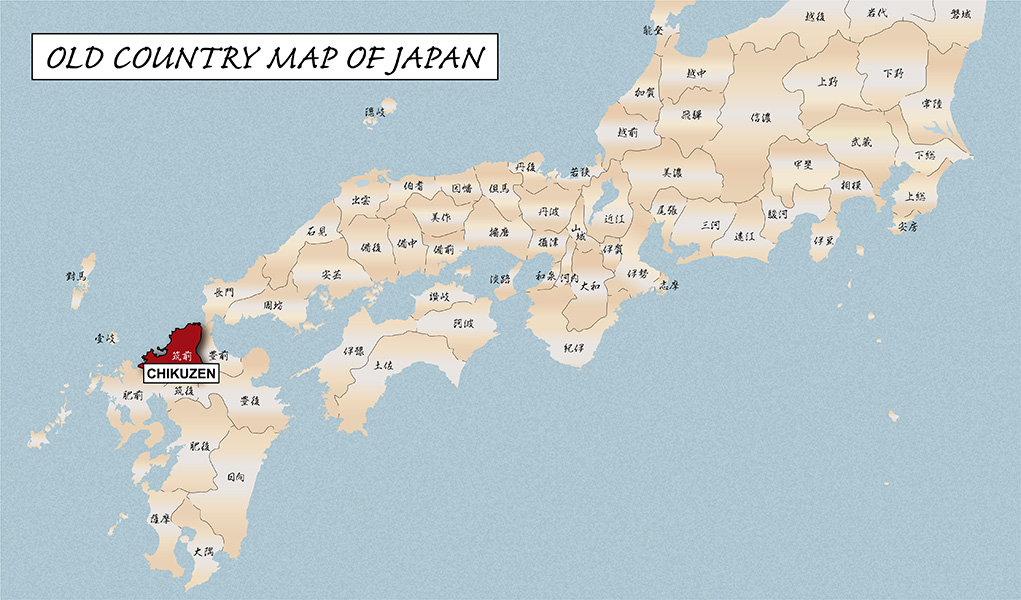
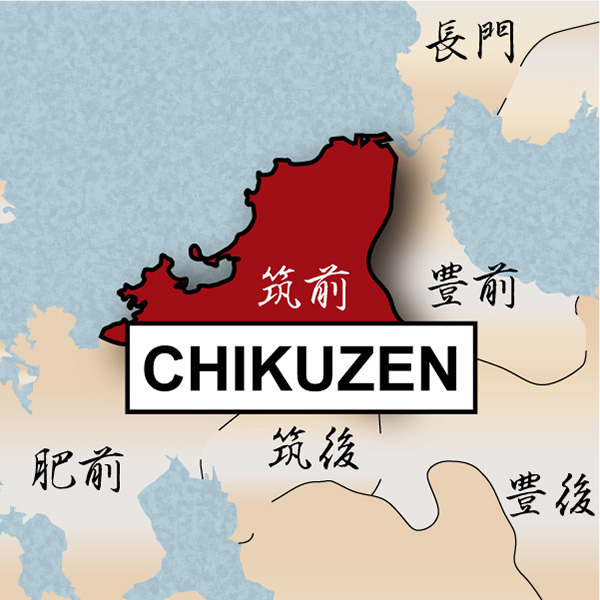
The Fondation of Nobukuni School
The Nobukuni school was initially founded by the first generation Nobukuni in Kyoto. The school stayed there for a few generations. However, the 4th generation Nobukuni SADAMITSU had to evacuate Kyoto city because the battle between the south emperor court and the north emperor court became severe. And as a result, Kyoto city was burnt(in the late 1300s). We called it the Nanbokucho war when the Japanese imperial court was separated into two.
Nobukuni SADAMITSU managed to escape and arrive at Usaha(Ohita prefecture)to serve the Ajimu clan. Nobukuni school prospered there from third to 11th generation. However, Toyotomi Hideyoshi, one of the three unifiers of Japan, destroyed the Ajimu clan during the late Azuchi Momoyama period (1582). And the 12th generation Nobukuni YOSHISADA moved to Chikuzen(Fukuoka prefecture), being invited by Kuroda Nagamasa, a famous feudal lord who served Toyotomi Hideyoshi (1602). It is said that the second-gen Yoshimasa also followed his father. Since then, Nobukuni school had been under the auspices of Kuroda clan for generations during the Edo period, and they exclusively forged for this clan.
This blade is appraised as a Tokubetsu Hozon Token(特別保存刀剣) issued by NBTHK(Nihon Bijutsu Touken Hozon Kyokai:日本美術刀剣保存協会). This authentication paper was only given to authentic Japanese swords, especially well preserved and high quality with artistic value.
【 Blade】
Cutting Edge Length(Nagasa): 67.5 cm ( 26.5 inches)
Curvature(Sori):1.8 cm (0.70 inches)

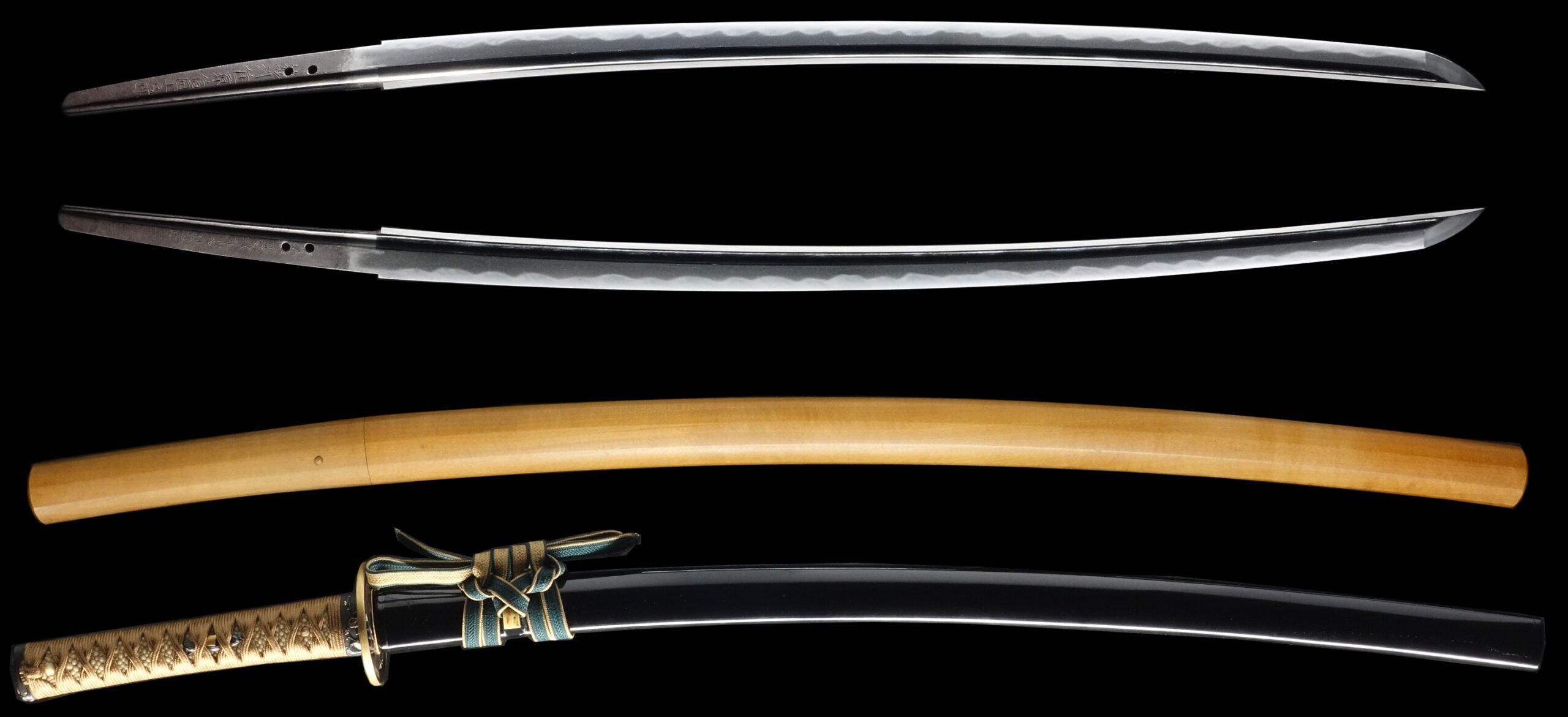
Hamon:
The crystalline structure which forms along the cutting edge of a blade as a result of the hardening process
Jimon(Jihada):
visible steel surface pattern created by folding and hammering during forging process
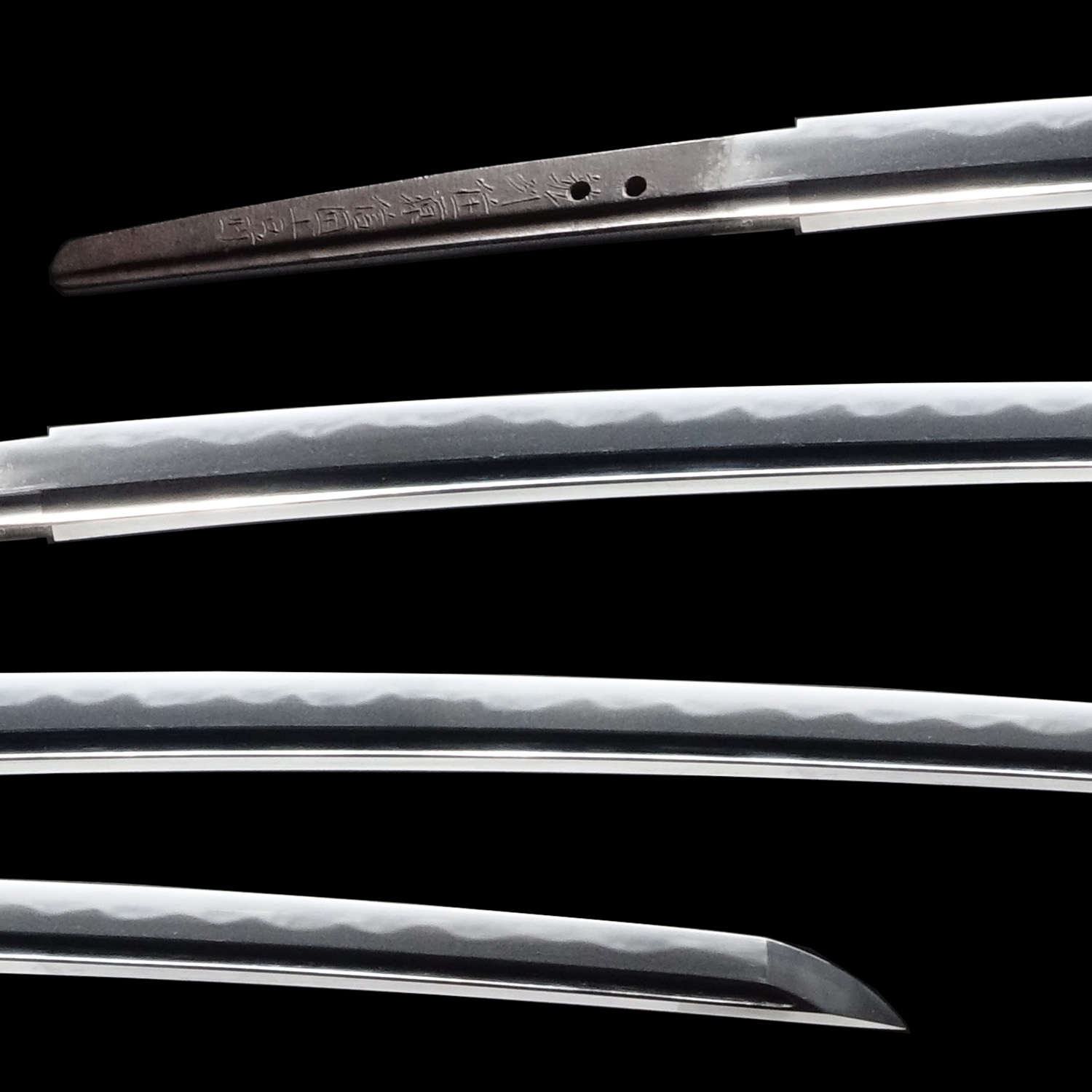
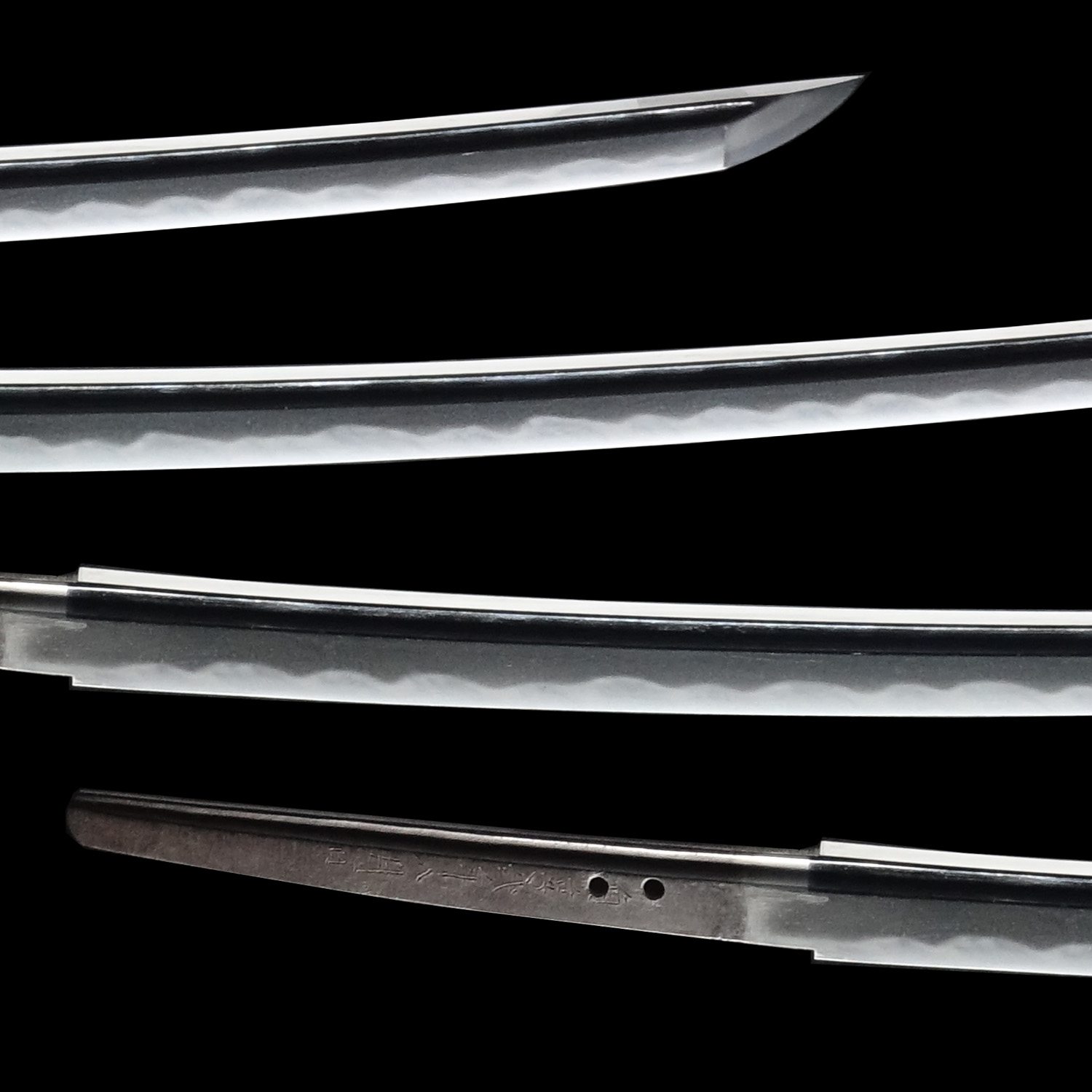
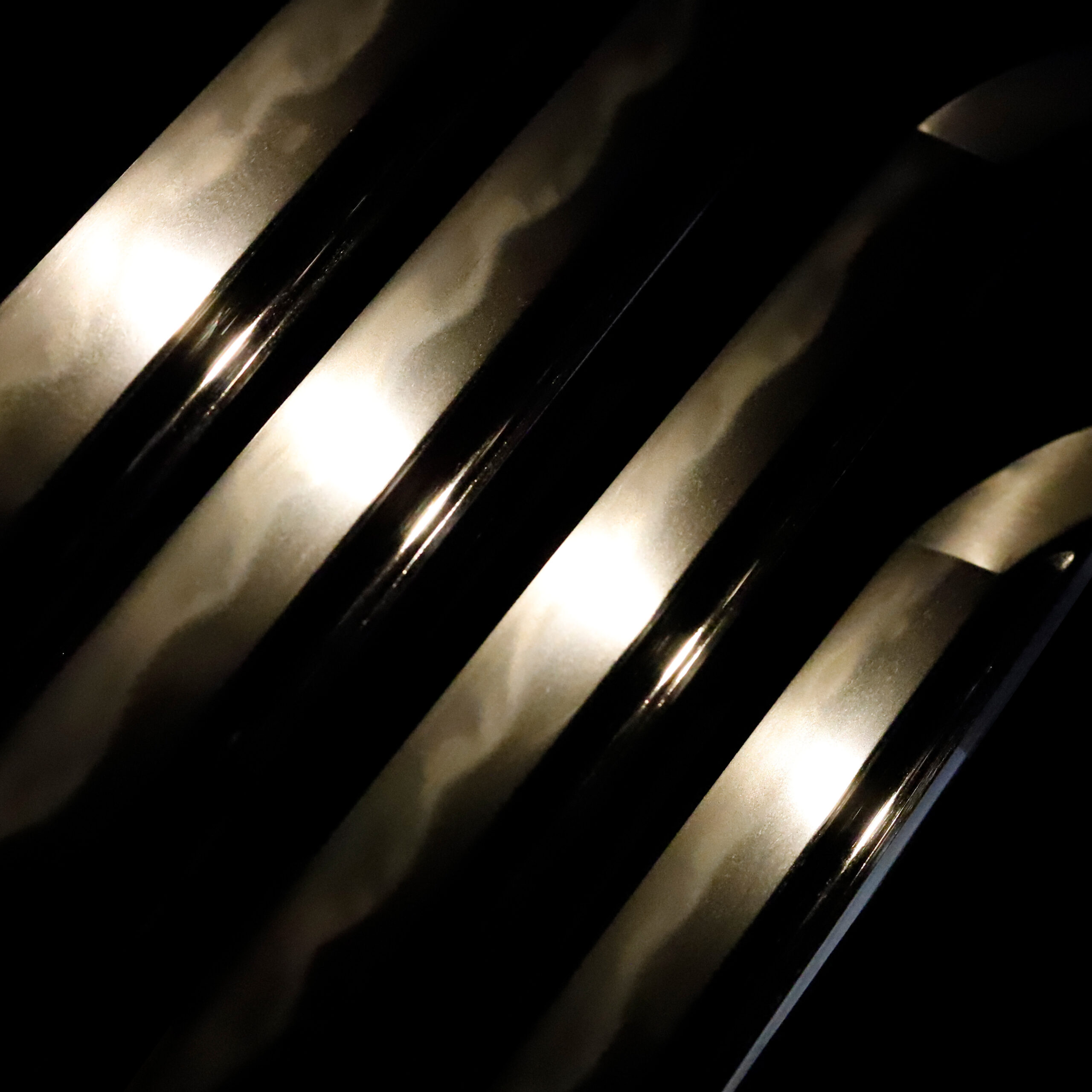

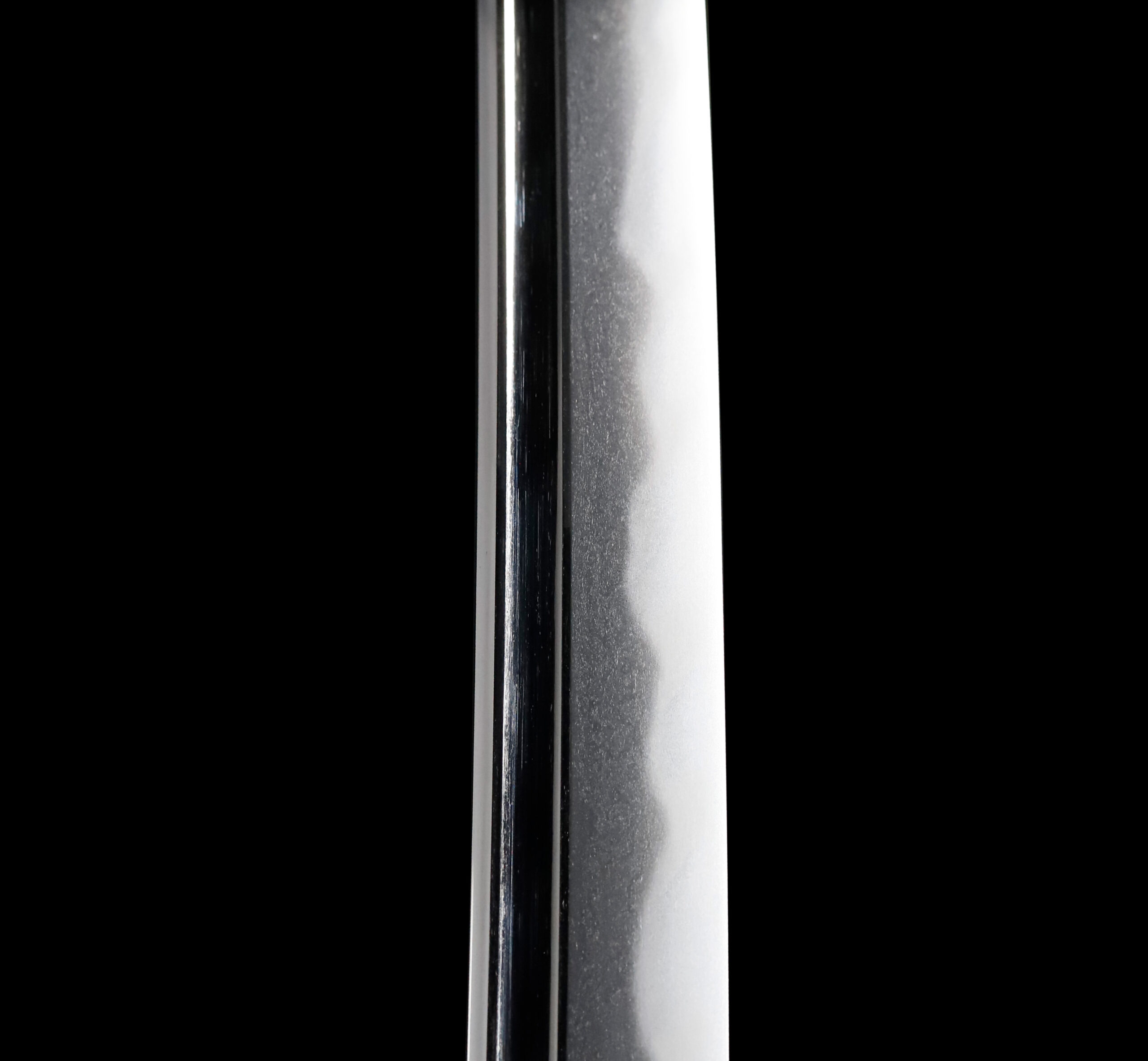
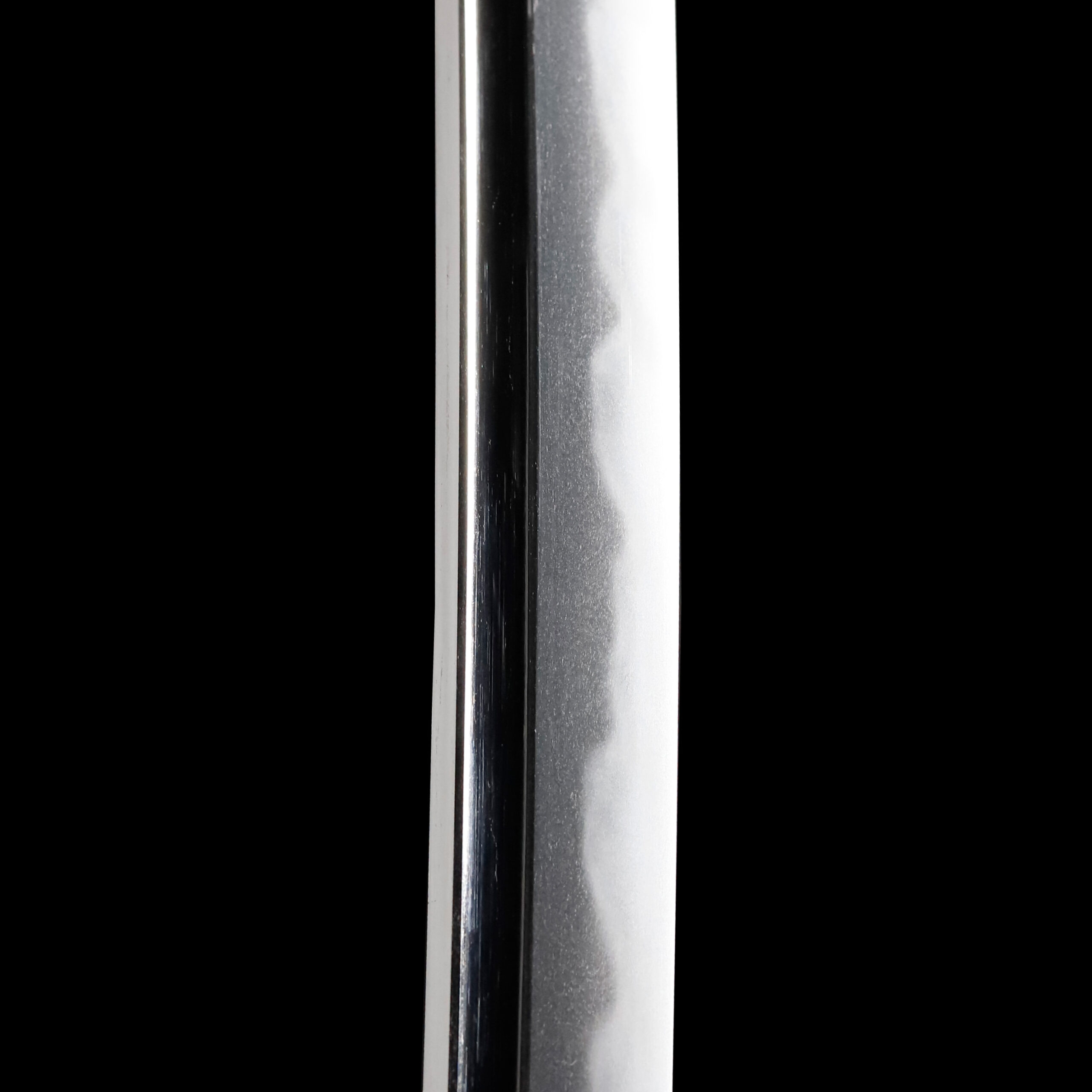
Nakago:Nakago is the tang of the Japanese sword.
Japanese swordsmiths left the black rust on the tang because it prevents red rust while the tang is in its handle. And the discoloration of the tang was created over time, and it is a great indicator for a Japanese sword specialist to estimate when the sword was forged.
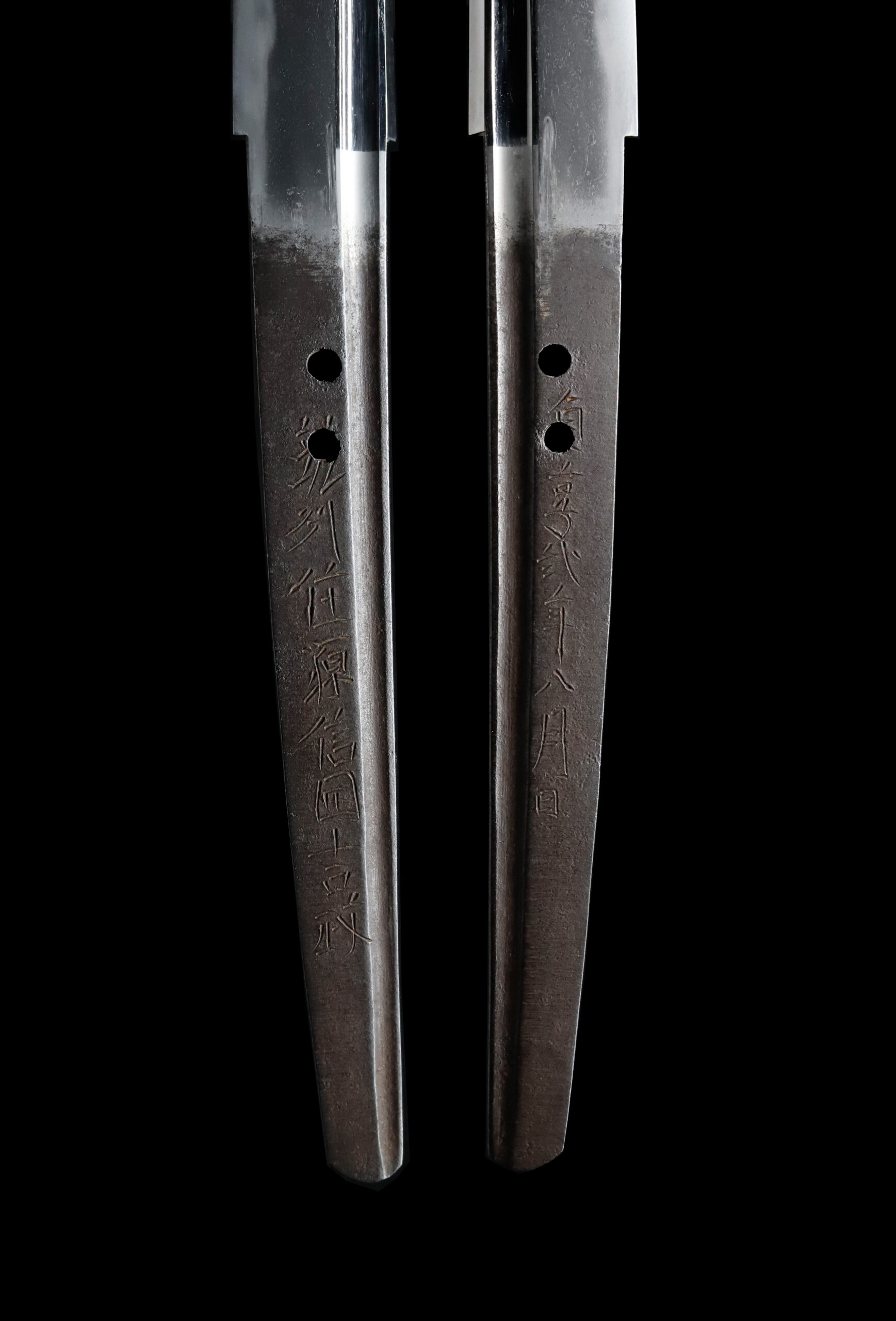
Koshirae: Koshirae is the mounting of the Japanese sword. There are several parts that consist of Koshirae such as Saya(Scabbard), Tsuka(Handle), Tsuba(Handguard).
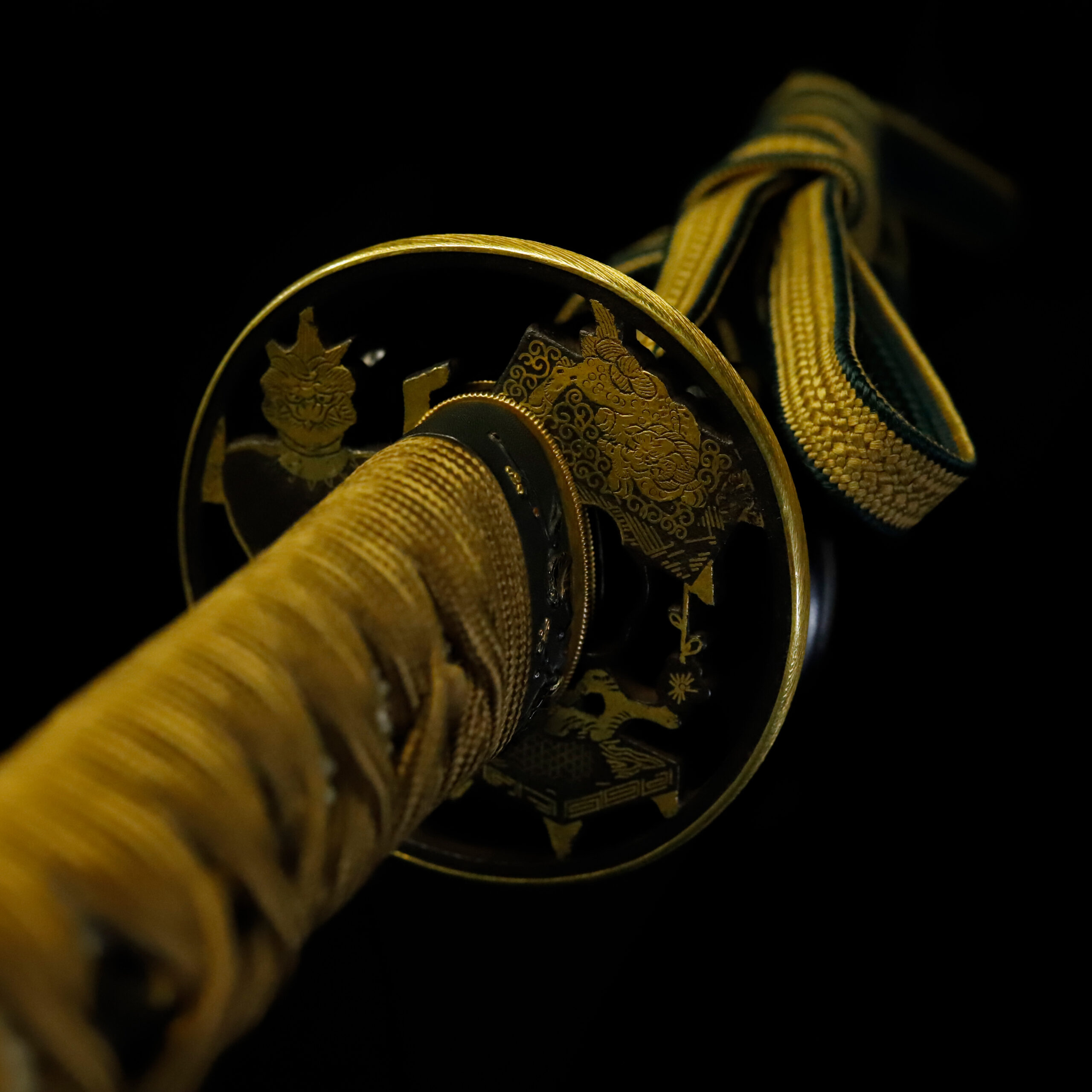
Fuchi-Kashira:A pair of matching sword fittings that cover the upper and bottom parts of its sword hilt.
The theme of this Fuchi Kashira is the Shukaidou Zu (秋海棠図, begonia grandis pattern). It is a perennial herb native to the continent that grows naturally in the fields and mountains of Japan. This plant is characterized by having heart-shaped leaves, and you would find it on this Fuchi Kashira. Although some colorings have already faded due to aging, golden paint partially remains on petals, leaves, and buds. The combination of black and gold colors creates an elegant atmosphere.
The surface of this Fuchi Kashira is decorated with the Nanako-Ji (魚子地) technique. This process makes a uniform minimal protrusions pattern by hitting the Nanako-Ji Tagane (魚子地鏨, a chisel for this technique) on a metal surface. This decorative technique is often seen on sword mountings.
There is an engraved inscription on the side of Fuchi part. It is written as follows: 正永 鐫. It means Masanaga (正永) made this work. Since there were several metalworkers whose name was Masanaga, we are unsure which Masaga is. However, here is a bare minimum of the fact that whoever he was, he was a virtuoso for producing this fine work.
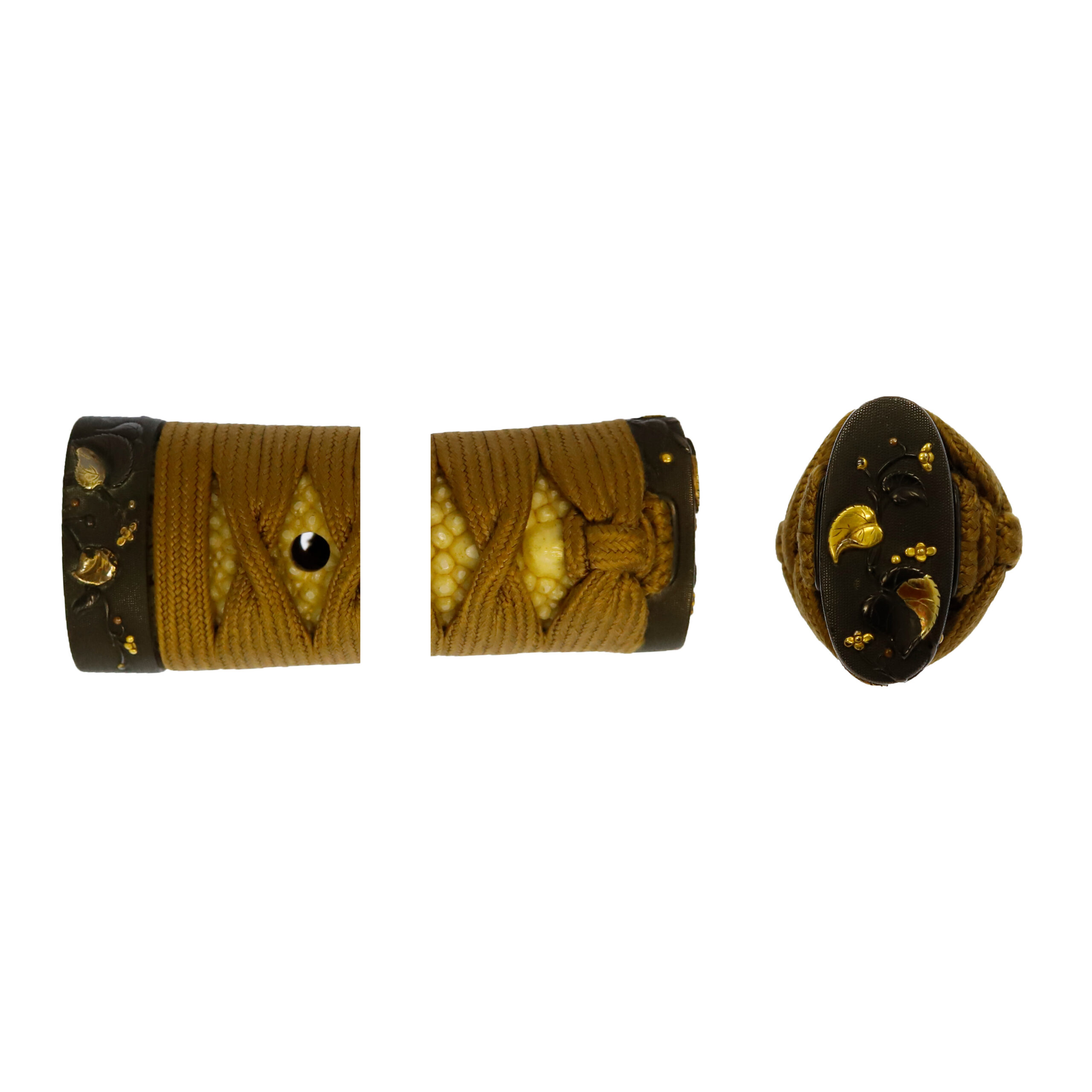

Tsuka and Menuki:Tsuka is the handle of the Japanese sword and Menuki is its decoration.
You would find a small boat-designed Menuki is attached to both sides of the handle. There is a bird perched on the edge of each boat. According to the certificate, the theme of this design is called the Ichiro Heian Zu (一路平安図). Initially, it was a prayer for safety on a journey that was expected to be challenging. However, today, it is also used as a word to pray for peace on the way to those who go on short trips. If we were to translate it into English, we think the following phrase would be appropriate: Have a nice trip.
After understanding the meaning of the words in this way, when we look at this work again, we realize that the design of birds and boats is not just a landscape depiction but a profound motif. In one ship, the bird sits on the boat’s bow; in the other, the bird is looking back on the ship’s stern. A bird staring forward might imply the safety of the voyage. The figure of a bird staring back might represent the nostalgia of a person who will start a journey. This interpretation is just one example, but the wish for a safe voyage is certainly included here.
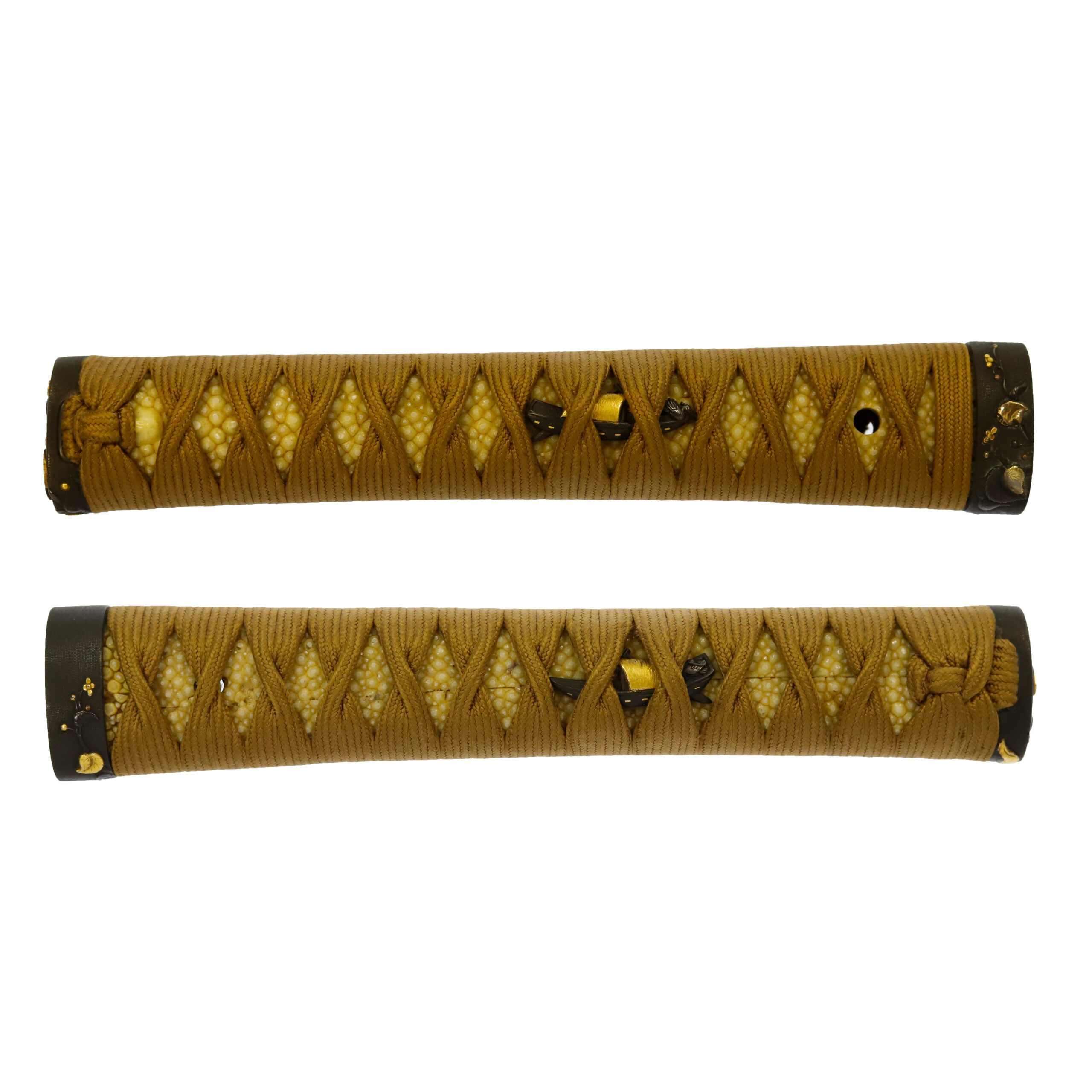
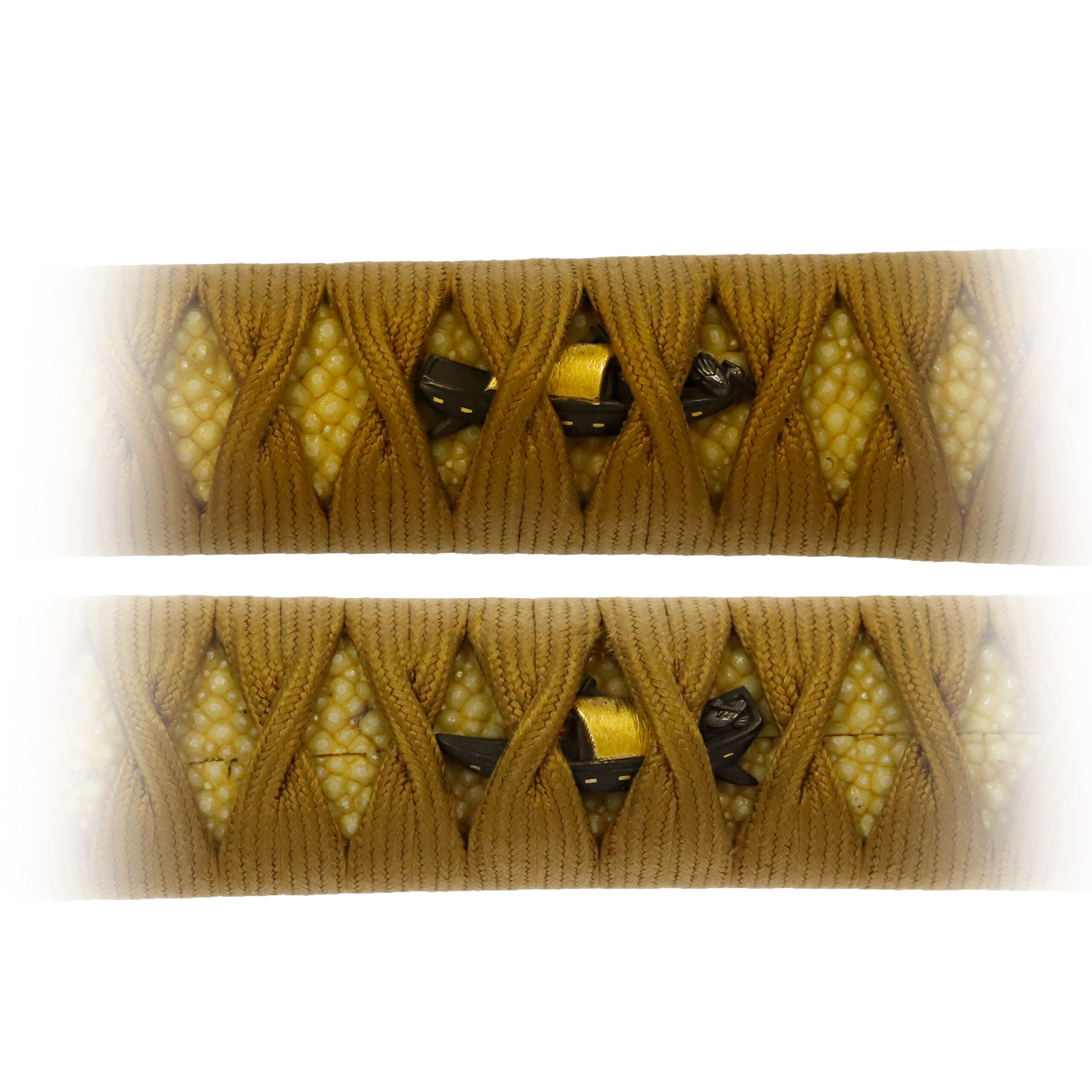
Tsuba and Habaki:Tsuba is the handguard for the Japanese Sword and Habaki is the equipment to make the blade not touch its scabbard inside. It prevents the blade from getting rusty and chipped.
This Tsuba’s Mimi (耳, edge) is framed with a thin gold plate. This decorative process is called the Fukurin (覆輪), and one of its purposes is to add beauty to works. In addition, it has practicality, such as preventing the wear of the edge part. Also, it prevents wear and tear on the Kimono if the edge damages it by touching the cloth.
This Tsuba’s design is made of a unique subject that combines furniture and animals, and plants. The certificate says it is the Choudo Sukashi (調度透) theme. The Choudo (調度) is a word that means familiar tools and furniture used in everyday life. Indeed, objects with short legs that seemed to be tables were engraved. A three-legged pot with an Oni (鬼, a monster with a human body with horns and fangs)-like decoration is probably an incense burner.
You would find the figure of an animal similar to a dog. We believe this animal is the Karajishis (唐獅子). The Shishi (獅子) means a lion in Japanese, and the Karajishi is a lion brought from the continent to Japan in the Toh period (唐, Tang dynasty, 618-907). The Karajishi typically has curly hair for its head, neck, body, and tail. A simplified pattern of this curly hair is carved as the body hair pattern of the Karajishi on this Tsuba. In Buddhism, the Karajishi is regarded as a symbol of wisdom, and Monju Bosatu (文殊菩薩, Manjushri Bodhisattva) rides lions. According to a theory, the Karajishi is the origin of Komainu (狛犬, stone guardian dogs that exorcize evil spirits). It shows this beast motif has been familiar to Japanese people since ancient times.
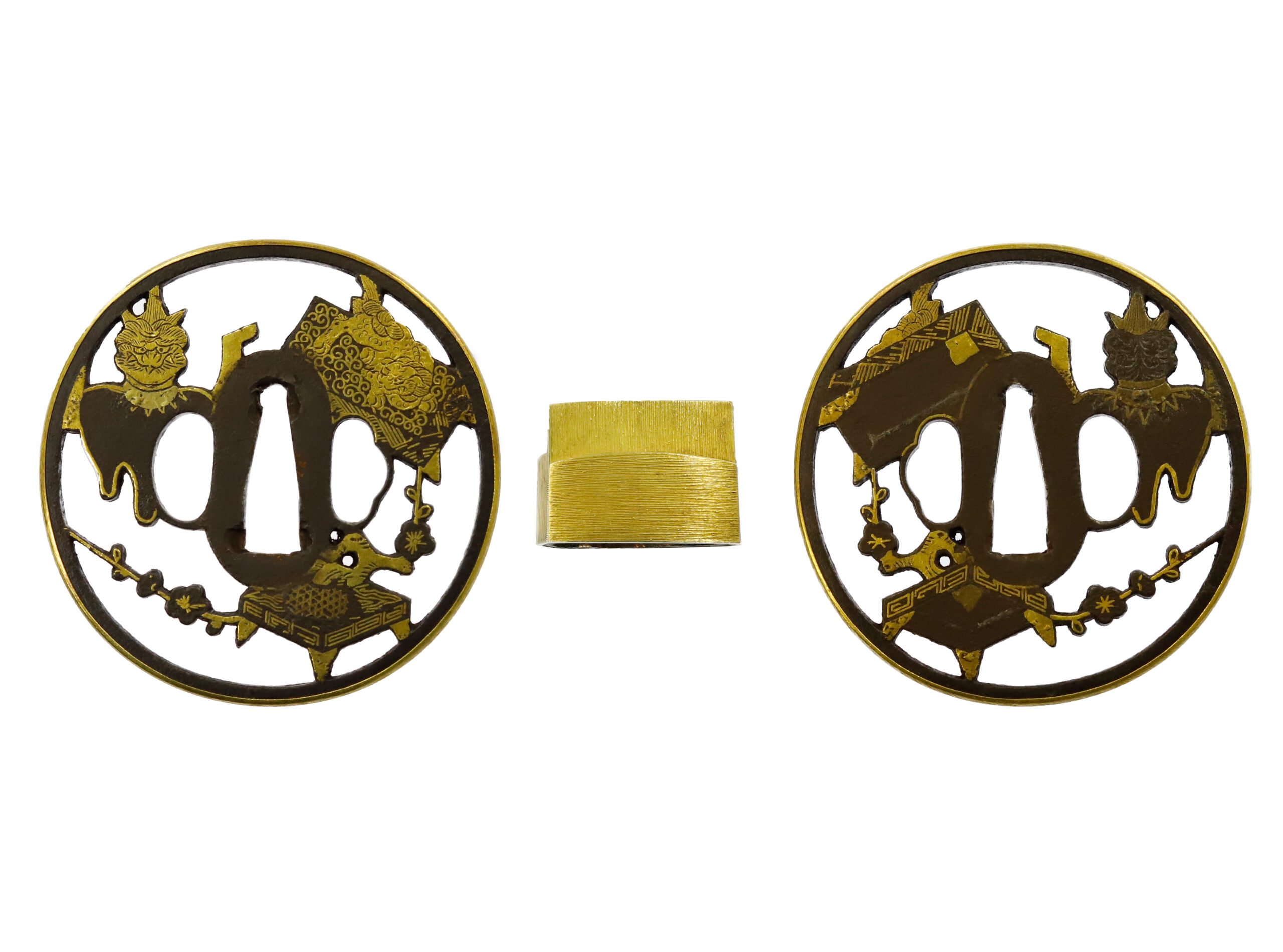
Saya: Saya is the scabbard for the Japanese sword.
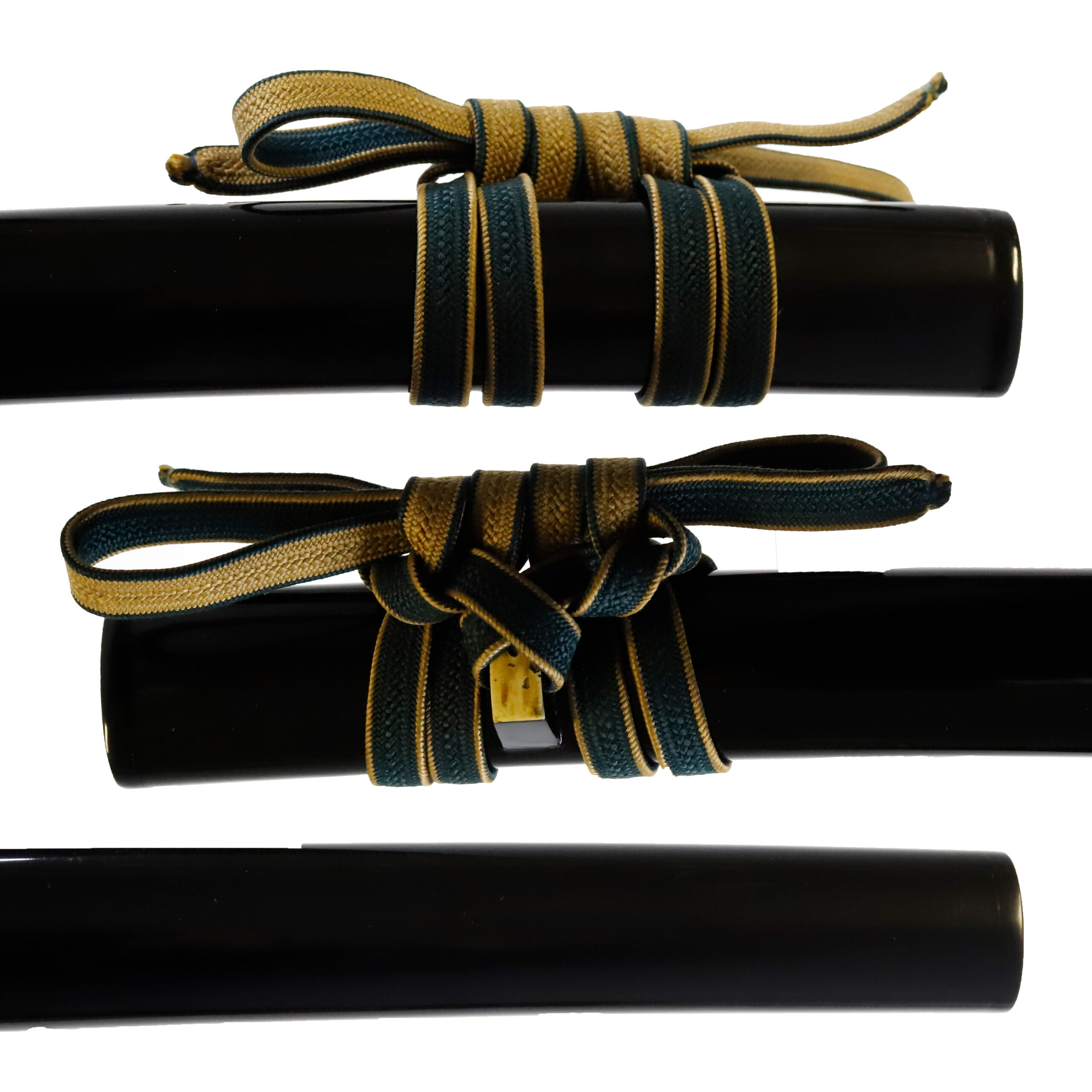
Authentication Paper:NBTHK TOKUBETSU Hozon Certificate for the blade (No. 1015801) and Koshirae (No.2007424)
NBTHK, also known as Nihon Bijutsu Touken Hozon Kyokai (the Society for the Preservation of the Japan Art Sword), is one of the oldest Japanese sword appraising organizations in modern-day Japan. They authenticated the blade on May 24th in the 3rd year of Reiwa (2021). Its Koshirae (sword mounting) was also authenticated in the same year. They appraised them as Tokubetsu Hozon Touken& Tosogu, the blade&sword mounting especially worth preserving for Japanese society. The purchaser will receive these original certificates as well. We can also translate what is written into English and make a PDF file for your record if you request.
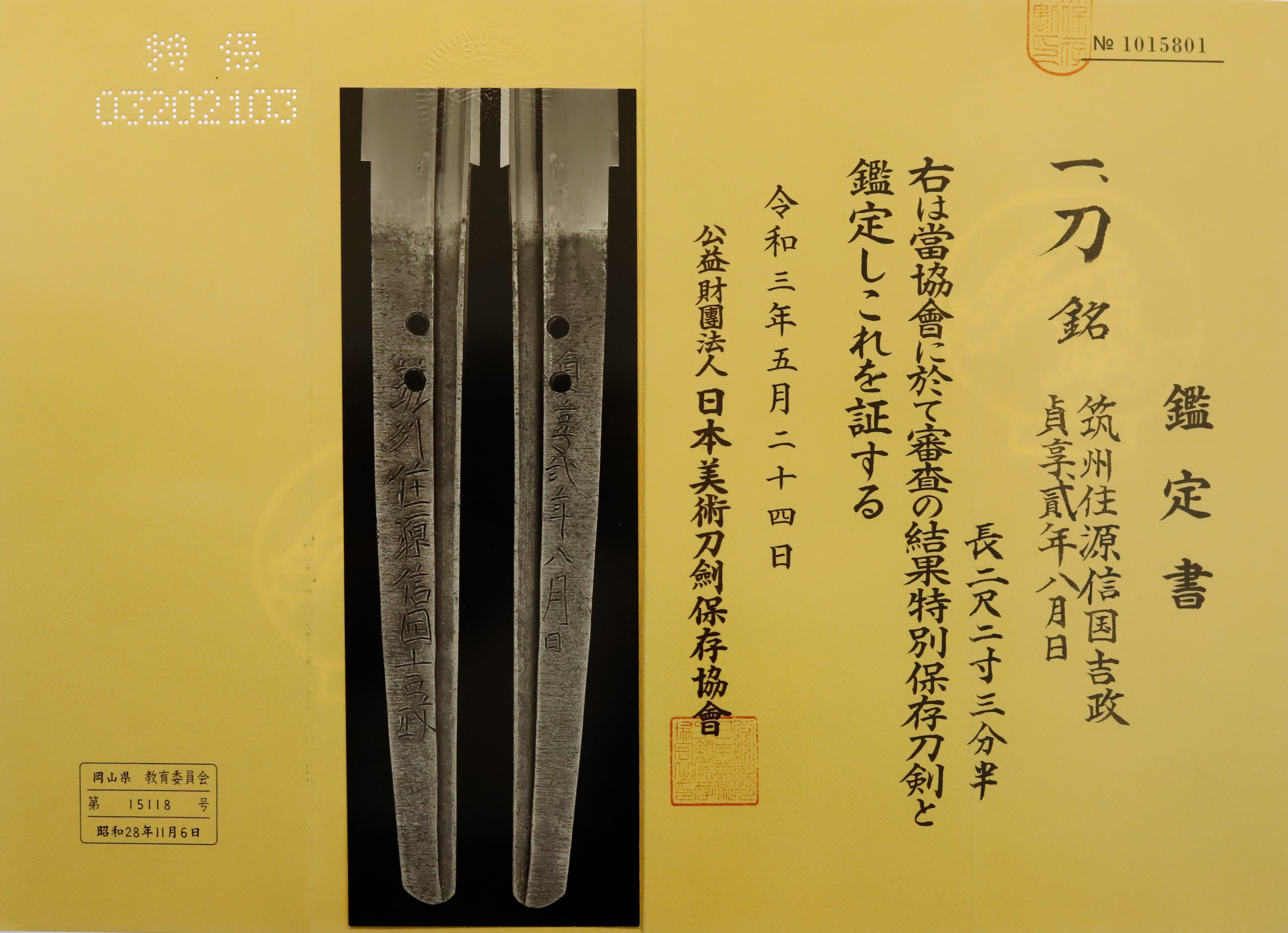
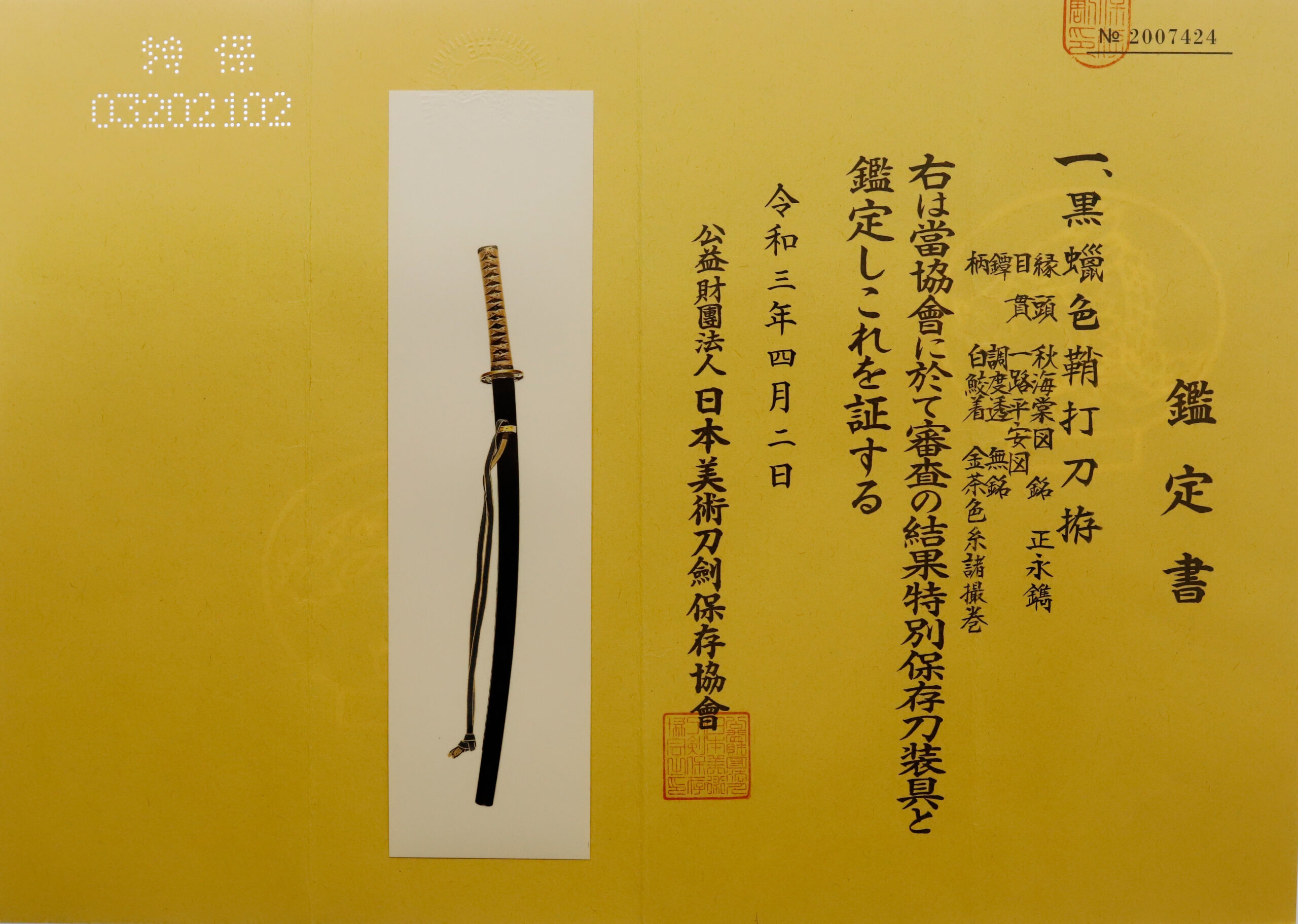
Registration Number : Okayama 15118
The Board of Education in Okayama prefecture issued a registration paper for this sword . It is called Jyu Token Rui Torokusho(銃刀剣類登録証). Bunkacho(The Agency for Cultural Affairs) acknowledges a Japanese sword with this paper as a work of art.
The sword needs to be traditionally hand-forged and made of Tamahagane carbon steel to be registered in the system. With this paper, its owner in Japan can legally own an authentic Japanese sword. Based on this registration number, we will apply for its export permit.
This paper will need to be returned to the board of education when the sword is being shipped abroad, but you can receive a copy of it. An English translation of this registration paper is available on request.

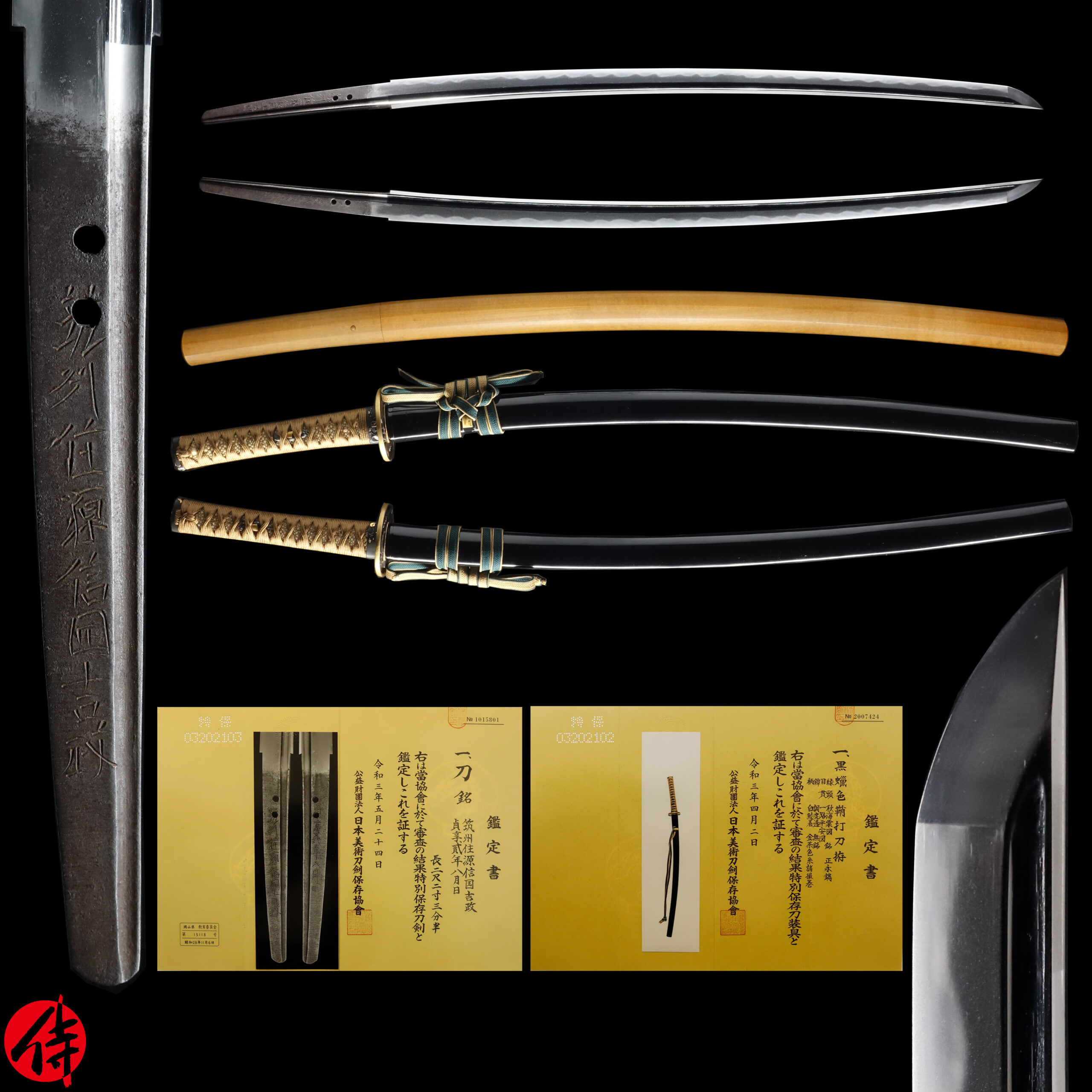
—————————————————————–
【About us】
Samurai Museum is located in Tokyo, Japan, exhibiting antique artifacts related to the Samurai history. Samurai Museum Shop is the place for those who are interested in Japanese culture and craftsmanship. We deal with antique Samurai swords/armor, traditional crafts made in Japan and so on.
【Japanese Sword& Export Process】
The Japanese swords we deal with are hand-forged edged swords made in Japan. It was made from the traditional carbon steel called TAMAHAGANE(玉鋼). Samurai Museum is familiar with the proper legal procedure for an antique/ authentic Japanese sword to be exported from Japan. We have sent more than 700 Japanese swords for the past few years (~2024) to amazing owners who appreciate its historical value.
Each Japanese sword is registered under the Agency for Cultural Affairs and the Board of Education in Japan. They issue a registration paper for each Japanese sword for its owner in Japan to legally possess it. The Japanese sword with its registration paper means it was traditionally hand-forged in Japan.
To legally export the sword from Japan to other countries, we will have to apply for its permit to the Agency for Cultural Affairs(Bunkacho) and return the original registration paper to the Board of Education. It normally takes around 2-4 weeks to receive this permit after submitting required documents. And we would like you to expect at least 1-1.5 months for your order to arrive at your given address after you ordered. For more detailed info, please click here.
It is allowed for residents in Japan to own authentic Japanese swords without a special license as long as they come with registration papers. Please feel free to contact us if you are a resident of Japan, whether temporarily or permanently. We will also assist you when you leave Japan and need to obtain the export permit.
【Payment Method】
We accept payment through Stripe (Credit card), PayPal, Apple Pay or ChromePay, all of which are secure payment methods. Also, you don’t need to make an account on Stripe for the checkout. If you prefer other payment method, please contact us. After confirming your payment, we will apply for an export permit. You may either pay in JPY, USD, AUD, CAD,EUR CHF or GBP. The price is set in Japanese Yen. Prices in other currencies are automatically calculated based on the latest exchange rate.

* If the amount is above 1 million JPY, Stripe or wire transfer will be the only options for payment.
【Shipping】
We have shipped authentic Japanese swords to the USA, UK, Canada, Mexico, Germany, France, Hong Kong and Australia. If you don’t live in these countries and like to order, please contact us first before making a purchase. We offer Free International Shipping as long as we can send antique Japanese swords by EMS.
We normally ship by EMS(Express Mail Service) provided by Japan Post. We will send you a tracking number for your order as soon as we hand it to the post office. We will put 100 % insurance on the shipping document without any extra charge. Based on the total amount, there might be a duty tax or other fee for you to pay, depending on the countries. We use package cushioning to protect the item and put it in a PVC pipe, which is one of the most secure packages because of its durability.
It will normally takes 5-14 days for the item to arrive at your given address after we dispatch it. Time of delivery is estimated as accurately as possible by the carrier but does not take into account any delays beyond our control such as by inclement weather, post office holiday seasons.
* If you live in Australia and like to purchase an authentic Japanese sword, please click here to know the detail.

【Review】
Here is one of the reviews we received from a customer who purchased an authentic Japanese sword from us. For more reviews, please click here.
“My experience overall with the whole process was wonderful. I had many questions about the history and process to purchase these treasures. All my questions were answered very timely and complete. The staff is very knowledgeable and very well versed if any questions do arise.”
【How to make sure the condition】
Please keep in mind that what you are going to purchase is an antique item. We uploaded high resolution photos for you to check its condition thoroughly. If you like to see more photos with different angles, please feel free to contact us. We will be happy to send them to you so that you can make informed decision. It is essential for us to know that you are happy with your choice of a sword. and we are prepared to use the best of our ability to serve you.
【How To Contact Us】
Please contact us through email, Facebook Messenger or Live Chat if you have any questions. You can find each icon on the right side of the website. Please click one of them to reach us. We will reply to you within 1-2 business days.
【The Art of Nihonto (Japanese Sword)】
Samurai’s history is a profound, eloquent legacy of ancient Japanese warriors in which millions of people worldwide are being fascinated. If you like to find out the art of Nihonto, please click here.
【A Guide to Japanese Sword Maintenance】
After acquiring an genuine Japanese sword, it is also important to know how to take good care of it. Here is the special video for you. Mr. Paul Martin, Japanese sword expert, shows you how to give proper maintenance to your sword. By mastering how to clean the Japanese sword, its aesthetic beauty will last forever.
When you purchase a Japanese sword from us, you can get a Free Japanese sword maintenance kit. It comes with four tools(Choji Oil, Uchiko Whetstone Powder, Peg remover, Oil Applicator). By watching the video instruction above , you can enjoy learning how to maintain your Japanese sword while appreciating it. If you have any difficulty assembling the sword or cleaning the blade, you can feel free to contact us.


MORE ANTIQUE JAPANESE SWORD FOR SALE
SWORDS WITHOUT CERTIFICATES FOR SALE
LEARN JAPANESE SWORD TERMINOLOGY
Thank you for reading all the information on the page. If you have any difficulty choosing the right Japanese sword for you, we will be more than happy to help you find the one that speaks to you the most. Please feel free to contact us.
